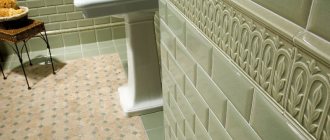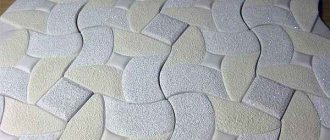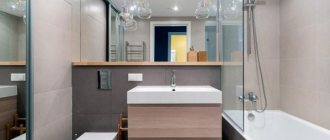Initially, the size of bathroom tiles affects the following factors:
- interior quality - it is necessary to achieve a rational combination of the number of seams and cut tiles on the sides;
- renovation budget - the price of the tile depends, among other things, on its size;
- labor-intensive finishing work - it is more convenient and faster to work with large tiles, but tiles that are too large will have to be constantly cut; due to their large weight, they are difficult to lay.
This guide provides a universal algorithm for choosing the format of floor and wall tiles when performing repairs yourself.
Classification of tiles by format
In professional circles, tile sizes are called format. This refers to the area of the product. There are three indicators in total:
- small format;
- average;
- widescreen.
When covering walls, you can use all of them, but not every model can be suitable for the floor. In addition to the standard size, the products differ in thickness. For wall structures, thinner types are produced. This is explained by the fact that there is almost no mechanical impact on the surface, unlike the floor. The thinner the tile, the easier it is to lay, and cheaper mixtures can be used to adhere to the wall.
Warning. Floor products can be used on walls, but reverse replacement is not permitted.
Classification is carried out according to form. There are several main types:
- triangular;
- square;
- rectangular;
- pentagonal;
- hexagonal;
- octagonal.
Basic forms
Due to inexperience, you can choose a sample of the wrong size.
Let's try to understand this difficult matter.
Mosaic tiles 10x10
Mosaic is a cladding that is assembled from small modules of 10x10 size, for example. The modules are assembled into a square and held on a mesh base. This design significantly simplifies the installation process. But assembling a 10x10 mosaic on your own is not so easy. To install modules, it is necessary to use professional skills and abilities, so not everyone decides to reproduce this process independently with their own beeches.
Small format tiles 10x10 or 15x15 have their advantages:
- To install it, you do not need to carefully level the base first.
- Only such tiles can be laid on a curved base.
- Modules measuring 10x10 look quite impressive in the interior.
The disadvantages of using the described material are also obvious:
- The installation process is labor-intensive, only painstakingly done work will allow you to enjoy beautiful results.
- Grouting joints takes a lot of mastic.
- In order for the seams to look decorative, it is necessary to choose expensive white grout. And these are additional costs.
- Filling the seams of 10x10 tiles should be done as evenly as possible, otherwise the mosaic canvas will look sloppy. Without certain skills it is very difficult to do this.
- Due to the presence of a large number of seams, the mosaic surface quickly loses its hygroscopicity. Improper use of 10x10 cm tiles often leads to the formation of mold and mildew.
- It is difficult to care for small-format tiles; white seams quickly become dirty.
How to determine dimensions
One rule should be taken into account: when decorating walls, select samples that correspond to the parameters of the room. If the room is spacious, then choose a larger one. It is not recommended to use large-format products in a small room. For low ceilings, the cladding is made with rectangular tiles, laid out vertically. In houses with high ceilings, the pattern is reversed, and it is important to emphasize the horizontal lines. Therefore, the long sides should be horizontal.
Do not forget about the influence of the tile surface, because the structure also affects the volume. The glossy surface visually expands the space.
Application of foam plastic
Repair will not be a difficult process if you choose foam boards. As a rule, light colors are chosen for the ceiling. Or shades of blue, beige. White material is cheaper, but looks noble and fits into any interior. It is not placed on the floor or walls. This is explained by the high moisture absorption of polystyrene foam and its fragility. Ceramic granite slabs designed to look like stone are used as flooring and wall coverings. Decorative designs enhance the space.
Also on topic: Boar tiles in the bathroom: interior examples
The installation of foam tiles should be approached with extreme caution due to its fragility. The use of water-based paint will significantly increase resistance to moisture, which is always abundant in the bathroom. The thickness should not be chosen more than 7mm. It is important to remember that it is not advisable to wash or wipe foam products.
Which tile is suitable for the bathroom, sizes, pattern
Most often they use a mosaic texture, which is made in sheet form. Sizes from 30x30 cm and above. The mosaic pattern can be mirrored, made to look like artificial stone, marble, metal, glass. If tiles are chosen for the floor, then it is best to choose a non-slip material. We should not forget about the need for access to communications. For this purpose, bathroom hatches for tiles are used, the dimensions of which must correspond to the laid squares or rectangles.
Polymer sand tiles are most often used when laying sidewalks. Some people like this finish, or a similar one, as a bathroom decor. This type of cladding can be imitated using special painting.
You can also achieve an imitation of marble and granite. It is clear that natural stone is very expensive, but the same effect can be achieved by using ceramics with the desired pattern. Visually it looks rich and unusual.
It is not necessary for the cladding to have a cold marble shade. The light beige coating looks very good. It gives the bathroom coziness and warmth. Light colors are suitable for the ceiling. It may be bluish or white. In the case where the room area is small, the floor should be dark shades like artificial stone or marble.
When materials with imitation marble or artificial stone are used in decoration, the bathroom is transformed and takes on a stylish look. Standard sizes of bathroom tiles allow this to be done. A design solution will help not only in choosing sizes and colors, but also in the direction of installation. It can be changed relative to the walls. All this will add unusualness and originality to the bathroom.
What sizes are flooring products?
For the floor, square tiles of the following sizes are traditionally chosen:
- from 50 to 300 mm. in increments of 50 mm;
- 327x327, 330x330, 350x350;
- 400x400, 408x408, 450x450;
- from 500 to 1000 mm., step is 100 mm.
Larger specimens are rarely used. The most common option is 300x300 mm.
Explanation. The thicker the product, the greater the load it must withstand. This has a significant impact on weight.
Rectangular products are used:
- standard: 30x60, 30x120, 40x60, 45x90, 50x100, 60x90, 60x120 cm;
- wood: 12x45, 15x45, 15x60, 16x99, 19x120, 20x50, 20x60, 22.5x90, 25x100.25x120 cm.
Manufacturers are constantly expanding the list and adding new dimensional characteristics.
Warning. The smaller the format, the more labor-intensive the installation.
Format table
The best option is:
- 100x200 mm;
- 150x200 (300) mm;
- 200x300 mm;
- 300x400 mm.
There are non-standard assortments that are used to create various designs.
Kitchen tiles
The regulation of kitchen floor tiles is not much different from others. The choice depends on the area and interior. It should be noted that small square-shaped samples are often used unless special decoration is provided.
For kitchen
Small kitchen products make the kitchen more comfortable and homely. It is known that using a small format helps to avoid increased waste that occurs when cutting. Often it is necessary to bypass structural elements that differ from rectilinear forms. For safety reasons, it is better to select samples with a rough surface, which will serve as protection against slipping.
What's suitable for the bathroom
The bathroom has a small area. Plumbing pipes may pass through the floor, making installation difficult. Therefore, the best option would be to use medium format products. It is recommended to use a coating with a structured surface. More often they choose tiles with sides of 300x300 mm. and smaller, up to 50x50 mm. Rectangular types from 100x200 to 300x400 mm are used.
Indicative table
In addition to standard ones, unique formats are sometimes used. Large-scale elements serve as a background, and small-scale elements create the desired ornament.
Schemes for laying out tiles on the walls
When decorating walls with tiles, you must follow the following basic rules:
- layout from the middle of the wall to the corners;
- the size of the cut tile is greater than or equal to half of the whole tile;
- the same size of cut cladding along the edges of the wall;
- either a complete match of the seams on the walls, floor, or their complete mismatch.
Matching seams of floor and wall coverings.
There is no particular visual gain from such a coincidence, but the labor intensity increases. Relative to the vertically drawn line, which is the middle of the wall, the tile can be in two positions - adjacent to the edge, overlapping with the center of the wall cladding aligned.
Depending on the ratio of the sizes of the wall and the tile, a wide beautiful cut at the junctions with adjacent walls can be obtained in both cases, as in the diagram below.
Two options for laying out tiles from the middle of the wall, left and right.
Square tiles are laid in a grid (vertical and horizontal seams are aligned with each other).
The “hog” cladding most often imitates brickwork with dressing in adjacent rows for half the length.
Designer cladding “hog”.
Rectangular tiles are laid vertically or horizontally in a grid. In the first case, the visual effect of increasing the height of the bathroom ceiling is achieved. The second option allows you to visually expand the area of the bathroom, “pushing the walls” of the room.
Rectangular tiles in the bathroom interior.
Mosaic fits perfectly on rounded walls and is often used for cladding pedestals, cabinets, homemade shelves, and plasterboard structures of curved, complex shapes.
The use of mosaics on surfaces of complex configurations.
The most difficult area inside a bathroom to decorate with ceramics is traditionally the wall with the doorway. Therefore, a special layout scheme is used here:
- on each section to the left and right of the doorway, the correct layout is performed according to the above algorithm;
- Whole tiles are mounted above the door from the sides to the middle;
- In the center, two cut tiles are used, the size of each of which is more than half of a whole tile.
Installation of tiles above the door.
The technology is considered universal, that is, it allows you to beautifully lay tiles of any size on walls of different lengths.
When laying out the tiles in height, it is necessary to take into account the level of the side of the bathtub and sink. Ideally, there should be no narrow strips of tiles above the sides of these plumbing fixtures.
The size of the tile allows it to be laid without narrow stripes above the plumbing.
In the average bathroom of an apartment in a multi-entrance building of most standard series, the walls are small, one or two of them are constantly occupied by bath accessories and wall cabinets/shelves. Therefore, instead of borders around the perimeter of the room, it is better to use vertical decor - tiles with a pattern, which is placed on walls free from furniture and clothes (usually above the bathtub, inside the shower stall).
Correct use of tiled decor in the bathroom.
What are the sizes of wall tiles?
For enclosing structures, samples of different shapes are used:
- square;
- rectangular;
- polygonal;
- in the form of a panel.
The main types of wall products have the following sizes:
- small format (60, 90, 120 mm);
- average value (180, 200,240,300,400,600);
- large up to 1200 mm.
Rectangular ones are also divided into three groups:
- 25x150, 75x150, 100x150, 100x200, 150x200 mm;
- 150x225, 250x300, 250x330, 250x400, 275x400 mm;
- 150x900, 300x600, 300x900 mm.
Wall samples
Polygonal types are available in small sizes from 150 to 250 mm. They may have an irregular shape.
Mosaic ceramics
Dimensions for bathroom and kitchen
Before choosing ceramics, you need to calculate its quantity. It is not enough to simply know the coverage area. To make installation less labor-intensive, you need to choose the size. The length of the masonry is divided by the width of the sample, plus the seam. The larger the ceramic, the larger the seam. For average values it is 3–5 mm. Sometimes large slabs are laid on the floor without seams, forming a monolith. If, when dividing the masonry distance by the sample, the remainder is very far from half, it is better to choose a different format or think about inserts.
Rectangular products with different aspect ratios are well suited as inserts, for example:
- 15x200 mm;
- 55x200 and 55x250 mm.
Samples from the lower indicator are inserted into the corner or used to visually divide the space. Ideal for edging the edges of a bathtub. Used for herringbone masonry. Parameters 15x200 are usually used when creating mosaics, which can have an area from 1 cm2 to 25 cm2.
Small squares are laid out diagonally. Medium square and rectangular samples are fixed directly or offset. Large samples are used only for the floor of large rooms. Some interiors may include this type of wall cladding.
The floor in the kitchen is tiled, because the walls are usually covered with kitchen furniture. Only part of the base remains open between the table and cabinets. This area is called an apron, but the owners themselves decide whether to cover it all or only part of it. The walls are covered with smaller, lighter material, and the floor is covered with large, rough, matte, darker color.
Corridor formats
Although the corridor is a non-residential room, you can immediately tell about the taste of the owners by its appearance. Small elements are rarely used unless they are original drawings or mosaics. By the way, mosaics can be made not only in small fragments, but also in medium format. For this purpose, products of different sizes are laid out. You can make a division: just before the threshold, use one format, and further along the corridor another. Everyone has their own taste, and you can’t subject everyone to the same rule. Some coating options are shown in the video:
To highlight the passage, long rectangular slabs are used. They, like sidewalk curbs, emphasize boundaries. Small rectangular pieces laid out in a herringbone pattern also look beautiful. Medium-sized square elements are often used, laid straight or diagonally.
Relation to room size
Even when a design project is prepared by a specialist, the final decision is always made by the customer. Taking into account the fact that the industry produces tiles of almost all sizes, in principle there cannot be a single correct decision when choosing its format for a particular bathroom. However, there are the following recommendations from professionals regarding the ratio of the length of ceramic tiles and bathroom walls:
- in open areas without hanging furniture, mirrors, hangers there should be 3 – 4 vertical rows with horizontal tile orientation or 6 – 7 rows with vertical orientation;
The number of rows on free sections of walls depending on the orientation of the tiles. - a mosaic with a chaotic distribution of different shades of the same color is visually perceived much better than small-sized tiles;
Decorating the bathroom with mosaics. - on large tiles, contrasting joints are recommended; on medium format cladding – plain joints in the color of the tile or a tone lighter/darker;
Highlighting large-sized cladding with a contrasting color of the seams. - “hog” cladding imitates brickwork, but does not have visual effects;
Decorating the walls of a wet room with hog tiles. - a medium-sized rectangular tile with an aspect ratio of 1:2 or 2:3 can visually “stretch out the walls” or “increase the height of the ceiling” when oriented horizontally or vertically in rows, respectively.
- Diagonal layout is suitable for square tiles. On the walls it allows you to hide littered corners, on the floor it prevents parallelism and random divergence of the walls.
Diagonal arrangement of tiles on the walls.
Dimensions of ceramic tiles
The thickness of these products ranges from a few millimeters to several centimeters. Sometimes ceramics mean porcelain stoneware, which is characterized by increased density and strength. It is often used on facades where a material that can withstand temperature and mechanical stress is needed.
Thickness often depends on size: the larger, the thicker. Tile material is divided into wall and floor. For walls where there is a weight limit, the thickness will be less; for the floor, on the contrary, it will be greater.
What should be the thickness of wall tiles in a bathroom?
The thickness determines what type of glue needs to be used and what layer to apply it. In this case, the base material is taken into account. For walls, choose a thickness in the range of 4–7 mm. Do not forget that the thicker the product, the more expensive it usually costs. Installation work is also becoming more expensive.
If mosaic is used, its thickness may be less than specified. Since it has a small area, this has little effect on its strength. The main thing is to follow the instructions for use. Sometimes products of different thicknesses are chosen for masonry, this makes it possible to create a three-dimensional pattern.
Thickness of floor products
Ceramic is a rather fragile material, so a thicker type is chosen for the floor. Moreover, the thickness depends on the load that will be placed on it. For example, for most rooms in the house 8 mm will be enough. This is a lightweight, cheaper ceramic. In the hallway or living room, a thickness of 11 mm may be suitable. Such plates have a sufficient margin of safety.
Thicker slabs are used in production areas. Porcelain stoneware, which goes through a different production cycle and has improved strength characteristics, is preferable.
Rubber tiles for flooring
The product has noise-absorbing properties. It is not exposed to high temperatures, does not crack, does not get wet and does not fade. They produce tiles in various colors and patterns. With its help, you can change the interior appearance of your bathroom or bathroom for the better. It can be easily installed on the floor, walls and even the ceiling. Easier to install than any other material.
Also on topic: Bathroom tiles: design photos
In addition to rubber coating, PVC tiles are used. These panels are also easy to mount on a surface. They wash well and look good. But PVC products do not have the same color range as the previous material. In addition, they are susceptible to mechanical damage. In case of inept installation, conditions for the development and spread of fungus can be created.
Bathroom wall tile sizes
Installation of vinyl cladding on walls does not require the use of moldings or other means. In addition, the use of this lightweight material ensures accessibility to technological communications. The surface of vinyl products is rough and does not slip like ceramics.
The main advantages of PVC panels:
- resistance to moisture;
- visually no different from ceramics;
- relative cheapness;
- painting like marble, wood, stone;
- environmentally friendly;
- The cladding looks decent and is resistant to moisture.
PVC tiles can be mounted on the floor, walls or ceiling using lathing. In the room, each wall will be reduced by 4 cm. The dimensions of bathroom tiles are most optimal at 15x15 cm. In most cases, ceramic products are considered the generally accepted standard. It is possible to create mosaic paintings from small tiles of 2.5x2.5 cm. But more often 33x33 cm or more are used. Any size looks good in a spacious bathroom. Small squares are placed in small rooms.
Ceramic is considered the standard cladding for walls, ceilings and floors. As a rule, dark colors are laid on the floor, and light tiles are used for the walls. The surface decorated with a patterned pattern looks good. And ceramics with a wood texture, designed to look like stone, marble are often placed on the floor, the lower part of the wall.
Products 10x10 cm are best suited for decorating bathrooms. Standard sizes of bathroom tiles range from 33x45, 30x60 cm.
Ceiling tiles
Covering the ceiling with PVC material should take into account the further installation of ventilation and lighting systems. Dimensions can be 30x30 cm. The thickness should not be chosen more than 7 mm. The panels are secured with self-tapping screws or dowels.
Does size affect quality?
Manufacturers calculate the size and thickness to ensure the material is durable. Therefore, the dimensions of products should not affect quality. Most often, the formation of defects is associated with improper masonry. If the layer of adhesive under the tile is uneven, then the possibility of cracks in place of the voids increases. The glue must be of high quality and applied strictly according to the instructions, taking precautions.
When all the rules are followed, the format and thickness are chosen correctly, the coating will last for decades. The final video shows the main parameters of the tile covering:
Selecting wall and floor tiles
Tiles have a large number of different characteristics. In order to choose the right tile from its rich variety, you must have at least minimal knowledge about it; this will eliminate the possibility of making mistakes when choosing.
A rich variety of tiles will allow you to select the most correct material for the overall design of the bathtub.
Bathroom tiles are usually made from ceramic. It is divided into two types: floor and wall. Ceramic floor tiles are usually thicker than wall tiles and have a less slippery surface. When choosing floor tiles, you need to pay attention to the slip resistance class of the tiles. Using tiles with an anti-slip surface will prevent future injuries and injuries from falls. For these purposes, you can choose relief or matte tiles, eliminating the choice of glossy tiles. Floor tiles must have a high level of resistance and hardness. The hardest material from which tiles are made is red clay, so it is recommended to choose tiles made from this material.
You need to choose wall tiles with a high level of density and wear resistance.










